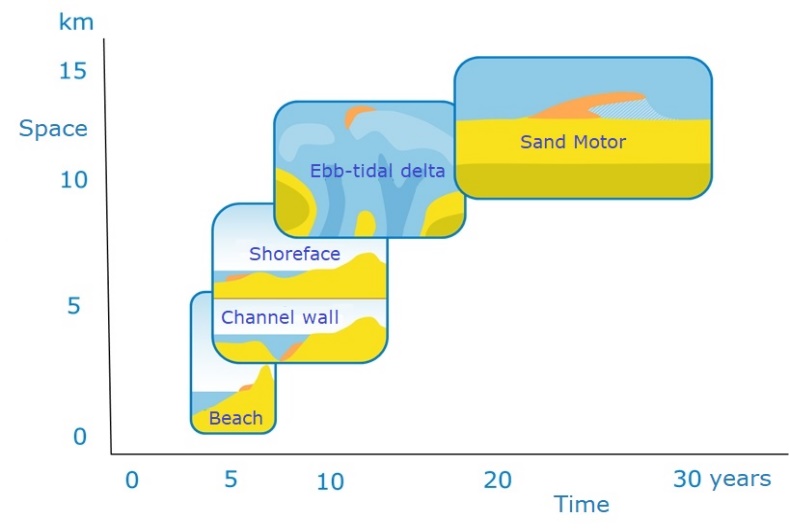L. Brakenhoff1*, Q. Lodder1,2, H. de Looff1, C. van Gelder-Maas1
1 Rijkswaterstaat; 2 Delft University of Technology
*corresponding author:
Introduction: the past and present
Starting in 1990, the main goals of Dutch coastal management are to sustainably maintain the flood protection and to sustainably preserve other functions of the dune areas (Ministry of Infrastructure and Water Management (MinI&W), 1990). In 2000, a third goal was added; to keep the sediment budget of the coast in equilibrium with sea level rise (MinI&W, 2000). In practice, these goals are achieved through sandy nourishments. Preferably, these nourishments are placed on the shoreface, but in practice (30-40% of the total nourished volume) beach nourishments are needed as well.
In the National Water Plan (MinI&W, 2009), new ways of adding sand to the system were encouraged. Since then, channel wall nourishments, ebb-tidal delta nourishments (i.e. at the Ameland Inlet) and mega nourishments (i.e. the Sand Motor) have been executed (Brand et al., 2022). These nourishments act at increasingly large spatial and temporal scales (Figure 1).
Methods: the future
Under accelerated sea level rise, it is the question whether the already expanded toolbox has all the tools needed to achieve the above mentioned policy goals. Also, questions arise on the implementation of these new techniques in legislation, and on their effect on functions like ecology. To answer these questions, the Knowledge Programme Sea Level Rise (KP SLR) was set up.
In the Sandy Coast theme of the KP SLR, Rijkswaterstaat studies (1) the physical impact of 0.5, 1, 2, 3 and 5 m of sea level rise on the sediment and nourishment demand of the coastal system, as well as (2) to what amount of sea level rise we can use our current nourishment toolbox and strategy, and by what measures we can 'stretch' them.
Results
Results will be combined in one or more nourishment strategies per sea level rise scenario. The effects will be determined of each strategy on several aspects, like costs, ecology, CO2 emissions etc. The results of this assessment will provide a first insight into the adaptation pathways we should take as a country with regards to sea level rise.

Figure 1: Spatial and temporal scales on which the various types of nourishments act.
References
Brand, E., Ramaekers, G., Lodder, Q., 2022. Dutch experience with sand nourishments for dynamic coastline conservation – An operational overview. Ocean and Coastal Management 217: 106008. https://doi.org/10.1016/j.ocecoaman.2021.106008.
Ministry of Infrastructure and Water Management (1990). Kustverdediging na 1990.
Ministry of Infrastructure and Water Management (2000). Derde kustnota: traditie, trends en toekomst
Ministry of Infrastructure and Water Management (2009). Nationaal Waterplan 2009-2015.
I. Surname1*, F.N. Another-Surname2 , Y. Next-Surname2
1 University Name, Country; 2 Organization Name, Country
* Corresponding author: mail.name@organization.org


